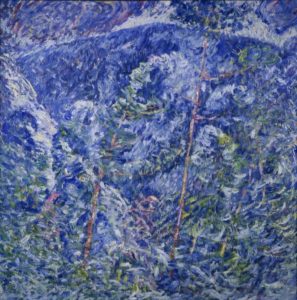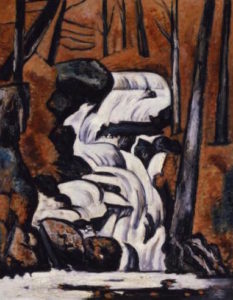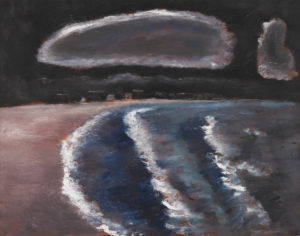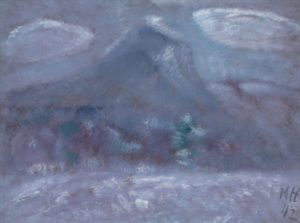 Marsden Hartley was a major American painter, to my mind a great one. Robert Hughes called him “the most brilliantly gifted of the early generation of American modernists,” a judgment with which I increasingly incline to agree. Yet his work has never come close to receiving its due, and “Marsden Hartley’s Maine,” which went up last week at the Met Breuer, is the first museum survey of his work to be seen in New York in nearly forty years.
Marsden Hartley was a major American painter, to my mind a great one. Robert Hughes called him “the most brilliantly gifted of the early generation of American modernists,” a judgment with which I increasingly incline to agree. Yet his work has never come close to receiving its due, and “Marsden Hartley’s Maine,” which went up last week at the Met Breuer, is the first museum survey of his work to be seen in New York in nearly forty years.
It isn’t hard to see why Hartley isn’t better known. He died in 1943, just before the abstract expressionists turned American art upside down. By then he had long since renounced abstraction to concentrate on painting the landscapes of Maine, his home state, working in a strong, at times almost rough-hewn style that is—like certain difficult people—easier to love than to like.
Clement Greenberg, always a shrewd observer of the American art scene, remarked in 1950 that Hartley’s landscapes
have an intensity and are animated by a desire to break through to a fresh and directer reality of pictorial feeling that bring them close somehow to the most recent abstract painting. I myself value them for their clumsiness and the sincerity of their failures almost as much for the rightness of their successes. There are and have been greater painters than Hartley, but few whose sentiment I value more.
 I myself would say “awkward” rather than clumsy, but otherwise Greenberg put his finger on it: Hartley was to Cézanne what Milton Avery, another chronically underappreciated American master, was to Matisse, and it is Cézanne’s deliberately, purposefully awkward way of portraying the visible world that shaped his later style more than that of any other painter. Such artists are rarely fashionable, whether in their own time or for long afterward.
I myself would say “awkward” rather than clumsy, but otherwise Greenberg put his finger on it: Hartley was to Cézanne what Milton Avery, another chronically underappreciated American master, was to Matisse, and it is Cézanne’s deliberately, purposefully awkward way of portraying the visible world that shaped his later style more than that of any other painter. Such artists are rarely fashionable, whether in their own time or for long afterward.
To be sure, most American scholars agree that Hartley was an artist of quality, and you’ll find at least one of his paintings hanging in most American museums, in part because his work is more affordable than that of his celebrated successors. (That’s why Mrs. T and I were able to acquire one of his little-known lithographs in 2006.) Many of the finest paintings and drawings in “Marsden Hartley’s Maine,” for instance, are owned by such regional collections as Maine’s Colby College Art Museum, Arkansas’ Crystal Bridges Museum of American Art, New Hampshire’s Currier Museum of Art, and the Saint Louis Art Museum.
 Nevertheless, opportunities to see and digest Hartley’s work in bulk are vanishingly rare, which is part of what makes this well-curated, sensitively hung show so important. It’s not a conventional retrospective, concentrating as it does on his paintings, early and late, of Maine and its people. To the extent that he’s remembered today, it’s for the work that he did in between, especially during the time that he lived in Germany, where he turned out a series of emotionally charged abstract paintings that have long found favor with critics who have little use for the rest of his output.
Nevertheless, opportunities to see and digest Hartley’s work in bulk are vanishingly rare, which is part of what makes this well-curated, sensitively hung show so important. It’s not a conventional retrospective, concentrating as it does on his paintings, early and late, of Maine and its people. To the extent that he’s remembered today, it’s for the work that he did in between, especially during the time that he lived in Germany, where he turned out a series of emotionally charged abstract paintings that have long found favor with critics who have little use for the rest of his output.
But Hartley, in his own opinion and in mine as well, was usually at his best when he painted Maine. “Maine is a strong silent country,” he wrote in 1939, “and so I being born there am able to express it in terms of itself with which I am familiar.” Accordingly, “Marsden Hartley’s Maine” contains dozens of stirring canvases that show the state he loved in a wide variety of aspects. My four favorite pieces in the show, “Winter Chaos, Blizzard” (1909), “Smelt Brook Falls” (1937), “Storm Down Pine Point Way, Old Orchard Beach” (1941-43), and “Mount Katahdin, Snow Storm” (1942), are all reproduced here. None is like its companions save in subject matter, yet all are instantly recognizable as his work. To see them in a single day, along with many other paintings of like quality, was a experience I never thought I’d have.
 It’s possible that I wouldn’t have come to love Hartley as passionately as I do had Mrs. T and I not spent so much time up north in recent years. Whenever I see one of his later paintings, I’m put in mind of Maine’s endlessly varied, endlessly fascinating landscapes and seascapes. All the more reason, then, why I should have been so thrilled by “Marsden Hartley’s Maine.” Nobody, not even Winslow Homer or John Marin, has had a richer appreciation of the stony, unyielding beauty of Maine, and I doubt you’ll ever get a better chance to see how much he made of it.
It’s possible that I wouldn’t have come to love Hartley as passionately as I do had Mrs. T and I not spent so much time up north in recent years. Whenever I see one of his later paintings, I’m put in mind of Maine’s endlessly varied, endlessly fascinating landscapes and seascapes. All the more reason, then, why I should have been so thrilled by “Marsden Hartley’s Maine.” Nobody, not even Winslow Homer or John Marin, has had a richer appreciation of the stony, unyielding beauty of Maine, and I doubt you’ll ever get a better chance to see how much he made of it.
* * *
“Marsden Hartley’s Maine” is on display at the Met Breuer, 945 Madison Avenue, through June 18. For more information, go here.
The show then travels to the Colby College Museum of Art in Waterville, Maine, where it will be on display July 8-November 12. For more information, go here.
A video preview of the show:
